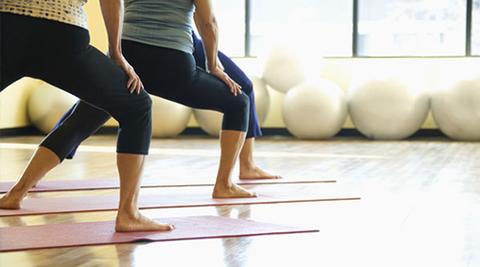Blog
3 Ways to Improve Strength in Your Pelvic Floor and Deep Core Muscles
What are Your Pelvic Floor and Deep Core Muscles?
Your deep core muscles consist of four muscle groups including your pelvic floor, transversus abdominis, multifidus, and diaphragm.
- Pelvic floor muscles provide support for reproductive organs and allow voluntary control over our bowel and bladder.
- The transversus abdominal muscle, or transversus abdominis, is a deep, horizontal abdominal muscle that supports our trunk during movement of the arms and legs.
- The multifidus are a group of muscles that run along the back of your spine that supports each of the joints during movement and helps maintain posture.
- The diaphragm is a muscle that sits under your ribs to assist with breathing.
Guest post by Dr. Amanda Olson, PT, DPT.
This is a guest expert post written by Dr. Amanda Olson, PT, DPT. She holds a Doctorate Degree in Physical Therapy from Regis University, a Certification of Achievement in pelvic floor physical therapy (CAPP-PF) through the APTA, and the Pelvic Floor Practitioner Certification (PRPC) through the Herman and Wallace Pelvic Institute. She is also a certified Stott Pilates instructor and RRCA certified running coach, which she finds useful in curating treatment approaches. She is also the CMO at Intimate Rose.
Why is it Important to Strengthen Your Pelvic Floor and Core Muscles?
The four parts of your deep core muscles work together to provide postural support when you are in a static position and stabilize your body during movement. Problems arise when either you have weakness in one or more of these groups or your body is not coordinating the contraction of these muscles as they are designed to work together to provide support. (Lynders)
These impairments can include low back pain, difficulty controlling bowel and bladder leading to incontinence of urine, feces, or constipation, diminished sexual function, decreased recovery from pregnancy, worsening of prolapse, and decreased ability to perform your desired daily activities. By strengthening each part of the deep core, you can help prevent or reduce these impairments.
3 Ways to Strengthen Your Pelvic Floor and Deep Core Muscles:
1. Pelvic Floor Muscle Strengthening
The best exercises to strengthen your pelvic floor are by performing a pelvic floor muscle contraction, or a Kegel. Kegels assist both men and women by increasing the strength in the pelvic muscles to allow for control of bowel and bladder and improved sexual function. Your pelvic floor muscles sit in between your pelvic bones at the bottom of your pelvic girdle. When you contract these muscles, they should pull up and in.
Flexing your pelvic floor muscles should feel like you’re trying to hold back the flow of urine (we don’t recommend you stop and start the flow of urine often on the toilet as this is harmful to the pelvic muscles, but you can do it once or twice to teach yourself that feeling). For men, Australian physiotherapist Jo Milios recommends to pull your “nuts to guts” to facilitate activating the correct muscles.
Perform 6-8 maximal contractions by pulling up and in as hard as you can for 3 seconds to improve the strength of your muscles. To improve the endurance of these muscles, perform 10-12 medium contractions (about 60% strength of your maximal contraction) and hold for 10 seconds.
Reminder from Beth: Be sure to relax fully between each contraction. Resting and stretching is just as important as flexing… and you know how much I like flexing 😉
Perform both types of these Kegel exercises 3x per day in a variety of positions including at least one time in sitting, one laying down, and one in standing to allow your muscles to be strong in all body positions. Be sure to never hold your breath during these contractions and ideally time your contraction as you breathe out.
These exercises are a small movement and can be done throughout the day without anyone noticing including waiting at a stoplight while driving, checking out at the grocery store, or when you are preparing for bed. Intimate Rose offers a great [Fit2B approved because everything is clearly explained and not weird] guide on performing exercises with weights.
2. Transverse Abdominal Muscle Strengthening
To strengthen your transversus abdominis, lay on your back with your knees bent. Place both hands on the bony prominences of your pelvis (anterior superior iliac spine/ASIS) which rests a few inches to the side and lower than your belly button.
Tighten the muscles between your two hands by thinking about pulling your belly button “up and in” towards your spine as you exhale. Make sure you can still breath lightly while holding this contraction for 10 seconds and perform 3x per day.
Once you have mastered this initial 10 second hold, it is time to progress this exercise to be able to hold your transverse abdominal contraction while you are moving one leg at a time.
Free transverse workout3. Multifidus Muscle Strengthening
To begin strengthening your multifidus muscle, lay on your stomach with a pillow under your hips. Alternate lifting one leg and the opposite arm feeling a contraction in your back and hold for 3 seconds before lowering and alternating sides. Make sure you continue to breathe. Perform each pair of arm and leg raises 10x for a total of 20 repetitions as you should alternate which side you move with each repetition.
To progress strengthening of your deep back muscles, advance to a bird-dog exercise where you are in a quadruped position on your hands and knees and raise one leg and the opposite arm while keeping your pelvis and trunk stable, hold for 3 seconds at the top before lowering your arm and leg. Alternate sides for 20 total repetitions. [This exercise is taught with tummy-safe cues in many Fit2B Workouts]
Specialized Training
Some individuals benefit from specifically designed training of these muscles from a pelvic floor physical therapist. These clinicians undergo specialized education to assess and rehabilitate the deep core muscles to evaluate your ability to safely begin a pelvic floor strengthening program and progress your program as you become stronger.
Studies have shown that approximately 15-30% of individuals do not perform a Kegel correctly without training. A pelvic floor physical therapist can provide this training to safely incorporate strengthening of the deep core muscles into your daily life. (Henderson)
Pelvic floor physical therapists can also help individuals with neuromuscular re-education to help restore the coordination of the firing of the four muscle groups of the deep core for appropriate stability during movement.
Sources
Lynders, C. The Critical Role of Development of the Transversus Abdominis in the Prevention and Treatment of Low Back Pain. HSS Jrnl 15, 214–220 (2019). https://doi.org/10.1007/s11420-019-09717-8
Henderson, Joseph Welles et al. “Can women correctly contract their pelvic floor muscles without formal instruction?.” Female pelvic medicine & reconstructive surgery vol. 19,1 (2013): 8-12. doi:10.1097/SPV.0b013e31827ab9d0







